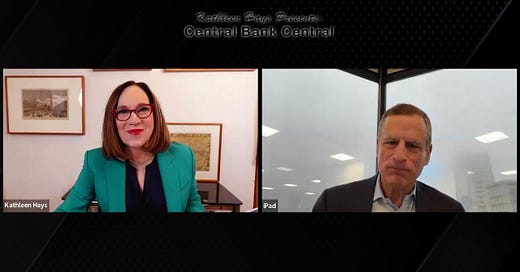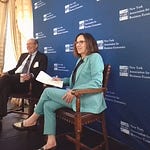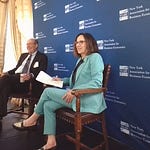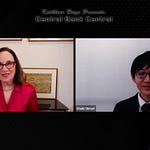Tariff turbulence that’s still hammering markets around the world and a much stronger-than-expected U.S. jobs report that normally would be kicking off a nice rally in the stock market but today it is not. That’s what Rob Kaplan faces as he joins me a to take a quick look at what all of this means for the Federal Reserve’s policy path, the U.S. economy and inflation - and importantly what may be ahead for President Trump’s next tariff steps.
Rob wears three hats that make him uniquely qualified for this task. He’s vice-chairman of Goldman Sachs, former president of the Federal Reserve Bank of Dallas, and a former professor and associate dean at the Harvard Business School.
As for tariffs, he has many concerns. One is that the initial Trump tariffs are so high that many countries won’t see much downside to retaliating. Another is studies that show “for every dollar you gain you lose a chunk of that to lower GDP growth and less tax revenue.”
As for the March jobs report, where payrolls rose a much stronger-than-forecast 228,000, Rob stresses that “it’s backward looking” and covers the period before tariffs were announced.
On traders starting to bet on more than 100bps of rate cuts this year amidst the steep drop in stocks and growing bets on a U.S. and even global recession, Rob says rate-cutting signals from the Fed are not likely. First he says he Fed’s best bet is to not overreact, realize it faces a “heavy fog” of uncertainty, and that it will best to keep it’s powder dry. In addition inflation is still too high. The Fed will not be quick to start easing unless major weakness in the economy forces their hand.
As we wrapped up our conversation, I asked Rob to put on his Harvard Business School hat and share what he would advise Donald Trump to do now if he could. You won’t want to miss his answer.
Structural changes: five of them 00:01:00.820
Let me talk about the whole situation. So we’ve got 5 big structural changes we've talked about before. Tariffs are one of them…
1) trying to deleverage the US Government, cut government spending with the view that deficits running at 7% of GDP in an economy at or near full employment. The view is, we need to reduce that to deficits. You pick it first, maybe 6% and 5% on its way lower. We need to de-leverage. That's number one. That's a huge structural change all by itself and very jarring as we've seen
Regulatory review 00:01:26.050
2) second big change, regulatory review in every industry, with the hope of improving productivity, growth. the issue with regulatory improvement. It will be helpful, but we don't know what that there'll be a time lag, and it'll take a while obviously related to the 1st thing fiscal. There'll be an effort to extend the trump tax cuts
Restructuring energy 00:02:15.250
3) 3rd big thing is over restructuring the energy ecosystem, and we don't need to cover that today. More drilling, easier to run a pipeline, easier to run a refinery lowering the price of the pump for low, moderate income families,
Excess immigration 00:02:15.250
…4) the Biggie, the 2 next ones, which are huge part of the reason we've grown as much as we have. The last number of years is 4) excess immigration we're reducing immigration labor force growth is going to decline meaningfully. And there's millions of workers in this country that are not criminals, but are undocumented or unsure of their status. And I can tell you they're not shopping, and many are not going to work that is underreported. This is before we ever get to tariffs.
Tariffs 00:03:03.380
5) And then you get to tariffs.
The surprises of this week 00:03:03.380
So what were the surprises this week? uncertainty about how we're going treat Mexico and Canada and logistics and supply chain arrangements, although
The tariff formula? Garbage-in Garbage-out? 00:03:38.980
Big surprise is the way they did the calculation which I won't go into that. The reciprocal tariffs were not actually based on the tariffs of the other country. They were based on a you know how big a deficit are we running?
The fallacy of bilateralism 00:04:01.850
<the ‘logic’ of this is…> if we're running a big deficit, then the barriers must be high, and if we're running a lower deficit the barriers must be low. And so the surprises that came to people… I don't know that anybody expected Vietnam to get pulled into this. So Vietnam, which we haven't talked a lot about, is a place where a number of us companies who moved outsourcing elsewhere. Vietnam was a place… Vietnam has a GDP per capita. $4,000 a person.
Markets react! 00:05:11.730
And so you saw the reaction in the world is and among companies here is and the markets. It's extremely negative. and I'll leave it at that
Job numbers are positive but look backward 00:05:24.075
In the midst of all that we got a positive job number today. But you know, it's backward looking. It's based on the previous month. It's before these tariffs were announced. And so it just… it just reminds everybody up to this point. Despite these challenges, we've had a solid economy. The issue is, people are very skeptical that the soft data is going ultimately move into the hard data <<Clarification: There has been talk that survey data (Soft Data) have been weaker than traditional Census and Commerce gathered data (Hard Data)>>. And so if I'm at the Fed, if I'm a business person right now, there's just enormous amount of uncertainty.
Huge tariffs, retaliation, escalation 00:07:13.650
I think most companies are, countries are calculating the current the status quo. What’s just been done is unacceptable. If we are going negotiate these down. it's not going to hurt our negotiating position to retaliate. I know there's a comment, if you do something we'll respond. But I think these initial tariffs are so high that I don't think these countries think there's a lot of downside to retaliating, and so China is not going to be the only one. Now. You then have to go through the top …1,000 companies in the United States. Some of them are more affected by Europe, some of them more affected by Mexico, Canada. Some of them are highly affected by China. I'm going to be careful in these not to use company names, but I have some big ones in mind that are very… the China market is very important to them. And China's retaliating. This not good for those companies. And, it reminds you, that this is likely going escalate.
Do massive Tariffs undercut the objective? 00:08:47.740
On the one hand, let's have more reciprocity, more level playing field on the margin. Let's encourage onshoring…but this may not be accomplishing either of those. And then the question is, (what) is the reason this being done? Because we want the revenue, because we want to deleverage objective number one, and this will help in that. And in the discussion of the tax bill. If there are more tariffs, maybe that would help. My concern is every study I've looked at on tariffs for every dollar you gain, you lose a chunk of that to lower GDP growth, less tax revenue and trying to compensate damage groups. So you got all these cross currents going on? As to why are they doing it? And why are they not seeing some of these issues in light of the pushback from any companies?
Letting the air out of the balloon- will it still float? 00:10:05.760
…remember the reason we were growing - This is now my view - the reason we were growing so strongly, heading into the end of the year is you had historically high fiscal spending right and, until recently, probably middle of last year. Historically, high labor force growth, due to immigration mainly undocumented. Both of those are being withdrawn. So no, the Jobs report is a great example of the data is interesting, but I wouldn't make too much of it either way.
The numerology of Fed rate cuts 00:11:10.260
So that the stock the markets are thinking the fed may cut 4 or 5 times if I'm inside the fed. That's not where the Fed is… up until recently. I would say the Fed Median is not 2 <rate cuts> at 2 minus. There are 8 people either at 0 <cuts>or 1 <cut>. Nine were 2, and then there were one or 2 that were higher… and the reason that they may undershoot where the market is <looking>, we’ve still got an inflation problem.
And...a reactive Fed 00:11:43.690
And the Fed has been fighting this battle. And so I think you may have heard me say before, I think, in the Fed's mind at this moment they are going to be more reactive than proactive. They’ve still got an inflation problem which makes them want to do very little. But if they see a big jump up in unemployment, they may be forced to do something.
What is safe Fed-Speak? 00:11:54.320
And what I'd be doing, therefore, as a Fed speaker today is being noncommittal. Whatever I do, do not give a view to the market that we're about to take action, and that we're going to, I would not. I would be saying, we're watching the situation. We are understanding. It's fluid. And I would try to say as little as possible, not make prognostications about what our what we're going or not going do, because the situation is going to unfold. And so, I would try to make as little news as possible.
A shock and a difficult transition 00:13:02.420
Yeah. So in this situation, I think the tariff announcement in hindsight, and at the time it was a shock. But we have other actions, slowing growth. Also, while it's going on, we're cutting government spending, we're reducing immigration, you heard me say, a year and 2 years ago, when people asked 2 years ago, Are we going to have a recession? I said, I don't see how, when fiscal spending is getting back to a more organic private sector led economy. I like the objective, but we have to understand organic private sector. The economy is cyclical. And so there's a lot of liquidity out there, though, right now. There are. There's a lot of potentially positive things going on. But yeah, this is a shock and an adjustment. And and so the issue is. how long does this uncertainty go?
Recession or not-here it comes: the future 00:14:24.620
Let's put it this way. If it goes on for months. I'm very concerned about what the implications will be if it gets addressed, and to settle down some of these question marks over the next couple of weeks. Maybe we have an opportunity to avoid a more severe downturn. But the most important insight I can give you right now is I don't know. And I think it's good to point out I don't know. There's no textbook for this. There's a lot of moving pieces and so the wisest thing I think the Fed could do is keep their powder dry.
“Talk to Contacts;” Does this approach elevate the Fed’s Beige Book? 00:15:04.260
Talk to contacts extensively. Don't jump to conclusions one way or the other. Keep your powder dry, and don't go overboard, either reassuring about the state of the economy or raising alarm bells. I would try to be noncommittal, because this is a fog, and give yourself a chance to to work through it. And let let events unfold a little bit here
Options for the Administration 00:16:47.290
I'm hearing these stories <about migrants>. Can you do something to clarify what your intentions are there in a way that will get those people to go back to their lives and contribute to the economy? That's a question they have to debate. And then the second one is what really are your objectives on tariffs? If revenue is primary, I might say you might want to trade off. Let's accept lot lower revenue net from this. Let's figure out what you're can you prioritize here?
What the Administration can’t afford to lose 00:18:01.580
You need to maintain some solid level of growth while you're doing the government spending cuts. You may debate the way they're doing it, but you need some solid level of growth. What you don't want is the severe fall off in growth where you lose tax revenues, and with all these cutting and jarring actions.
Rob Kaplan
Rob Kaplan is Vice Chairman of Goldman Sachs and a member of the Management Committee. Previously, Mr. Kaplan served as President and CEO of the Federal Reserve Bank of Dallas. Before joining the Fed, he was the Martin Marshall Professor of Management Practice and Senior Associate Dean at Harvard Business School (HBS).
Mr. Kaplan initially joined Goldman Sachs in 1983 and became a Partner in 1990. In 2002, he became Vice Chairman of the firm with global responsibility for the Investment Banking and Investment Management Divisions. He also served as Co-Chair of the Partnership Committee and Chair of the Goldman Sachs Pine Street Leadership Program. In 1998, Mr. Kaplan became Global Co-Head of Investment Banking and a member of the Management Committee. His previous roles included serving as Head of Asia Pacific Investment Banking, Co-Chief operating officer of global Investment Banking and Head of the Americas Corporate Finance Department.
Mr. Kaplan retired from the firm in 2006 to join HBS, becoming a Senior Director at that time.
Mr. Kaplan is Chairman of Project ALS and Co-Chairman of the Draper Richards Kaplan Foundation. He is a board member of Harvard Medical School and St. Mark’s School of Texas, and is a member of the George W. Bush Institute’s Advisory Council. He is also an Advisory Board member of the Baker Institute. He serves on the Bipartisan Policy Center President’s Council and on the Board of Directors at The Holdsworth Center.
Mr. Kaplan is the author of three books on leadership, What You Really Need to Lead, What You’re Really Meant To Do, and What to Ask the Person in the Mirror.














Share this post